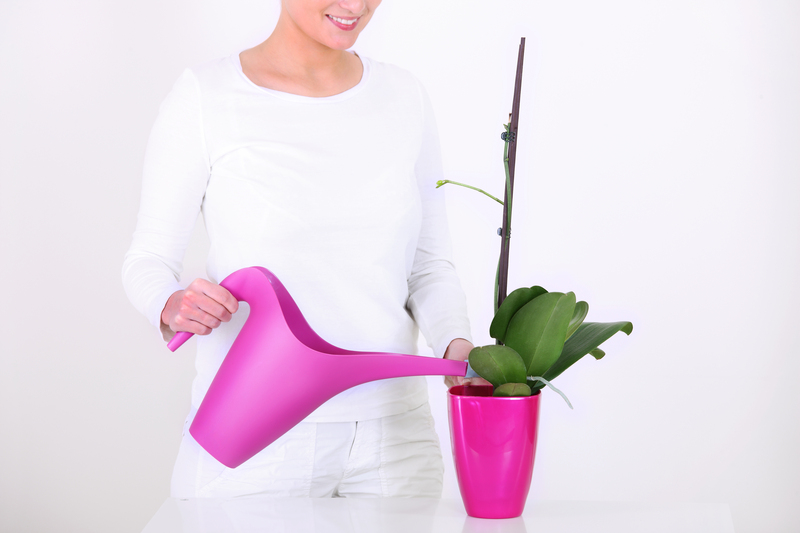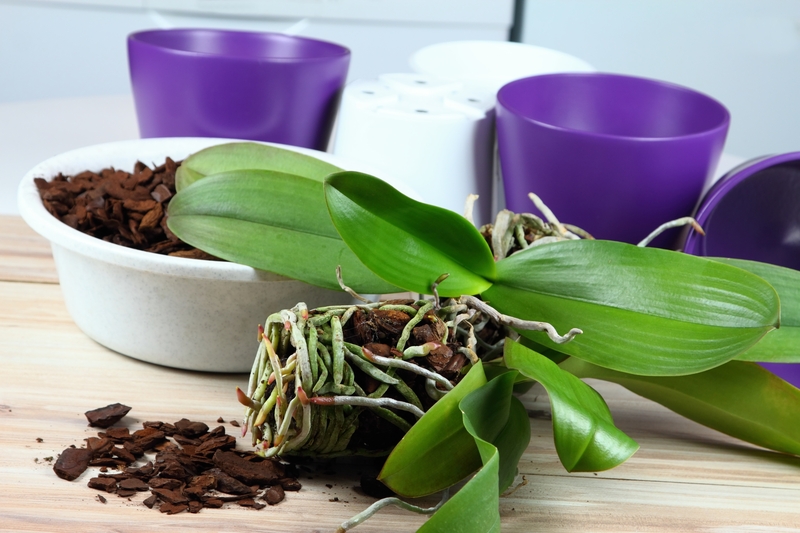From Bud to Bloom: Orchid Care Tactics
Posted on 17/05/2025
From Bud to Bloom: Orchid Care Tactics
Orchids have long held a place among the favorite indoor plants for both novice and seasoned gardeners. Their exotic allure, intricate blossoms, and striking foliage make them a popular choice worldwide. However, many enthusiasts find themselves wondering how to take these beautiful plants from bud to bloom successfully. In this all-encompassing guide, we'll dive into orchid care tactics that help ensure your flowering friend thrives and dazzles with its glorious blooms.

Understanding Orchids: The Basics
To master orchid cultivation, it's crucial to understand the basics. Orchids form one of the world's largest plant families, with over 25,000 species and more than 100,000 hybrids. Their diversity may seem intimidating, but most orchids grown indoors belong primarily to the Phalaenopsis (Moth Orchid), Cattleya, Dendrobium, and Oncidium species.
- Phalaenopsis: Most common, best for beginners.
- Cattleya: Known for bright, fragrant blooms.
- Dendrobium: Hardy and diverse.
- Oncidium: "Dancing Lady" orchids, love humidity.
What Makes Orchids Unique?
Orchids are epiphytes, meaning they grow on other plants - usually trees - rather than in soil. Their unique root systems allow them to soak up moisture and nutrients from the air and rain, rather than depending solely on what's found in the ground. This unique trait informs many of the special tactics needed for premium orchid maintenance.
The Essentials of Orchid Care
Achieving healthy orchid growth from bud to bloom requires attention to several key factors. Let's break down the essentials every orchid grower needs to master.
1. The Right Light
Light is possibly the most important aspect of successful orchid care. Most orchids prefer indirect, filtered sunlight. Direct sunlight can scorch leaves, while too little light stunts flower production. Place your orchid near an east or west-facing window for best results.
- Phalaenopsis: Prefers low to medium light; ideal for indoors.
- Cattleya: Needs bright but filtered light.
- Dendrobium: Prefers strong but indirect sunlight.
Signs of improper lighting include:
- Dark green leaves (not enough light)
- Yellow or scorched leaves (too much light)
Tip: If natural light is insufficient, consider supplemental grow lights.
2. Optimal Watering Practices
Overwatering is one of the most common mistakes for orchid growers. Orchid roots need air as much as they need moisture. Most varieties fare well with watering once per week, allowing the growing medium to dry out slightly between watering.
- Use tepid water and avoid wetting the leaves directly.
- Water thoroughly, letting excess drain away.
- Never let the orchid sit in standing water.
- Humidity levels should ideally be around 50-70% for best results.
Pro Tip: If your home is dry, place the orchid pot on a humidity tray or use a room humidifier.
3. Feeding Your Orchid
Orchids are not heavy feeders. Use a balanced, water-soluble orchid fertilizer (20-20-20) twice per month during the active growing season (spring and summer), and reduce feeding to once per month during fall and winter.
- Always fertilize after watering to avoid root burn.
- Use half-strength solution to prevent fertilizer buildup.
- Flush the pot with clear water every other month to remove excess salts.
Proper feeding routines will encourage lush growth and vibrant, long-lasting blooms.
4. Potting Medium & Repotting
Unlike most houseplants, orchids generally don't thrive in traditional potting soil. Instead, they require a special orchid mix, often consisting of bark, charcoal, coconut husk, or sphagnum moss, to mimic their natural epiphytic environment.
When to Repot: Most orchids need repotting every 1-2 years, or whenever the potting medium breaks down and becomes dense, restricting airflow to the roots.
- Choose a pot only slightly larger than the root system.
- Trim off dead or mushy roots before repotting.
- Repot after flowering, when the plant is not actively blooming.
From Bud Set to Stunning Bloom
Watching an orchid develop buds is an exciting time. To ensure those delicate buds open into radiant flowers, additional care is required during the budding stage.
1. Temperature Control
Temperature fluctuations play a critical role in bud development. Most orchids prefer night-time temperatures 10-15 degrees cooler than daytime temperatures, which triggers bud formation. Ideal temperature ranges:
- Phalaenopsis: Day: 75-85°F / Night: 60-70°F
- Cattleya, Oncidium, Dendrobium: Day: 70-85°F / Night: 55-65°F
Avoid placing orchids near heaters, radiators, cold drafts, or air conditioning vents.
2. Adequate Humidity
Bud blast - the failure of buds to open - is often caused by low humidity. Maintain humidity between 50-70% with a room humidifier or humidity tray.
3. Proper Air Circulation
Good airflow reduces the risk of fungal diseases and encourages healthy development. Use a small fan on a low setting to keep air moving, but avoid drafts that could chill the plant.
4. Avoiding Stress
Any major changes in environment during the bud stage - such as repotting, drastic moves, or sudden temperature shifts - can cause buds to drop. Maintain consistent conditions for the best display of blooms.
Troubleshooting Common Orchid Problems
Even the most meticulous orchid keeper can face challenges. Here are solutions for some of the most common issues affecting orchids as they mature from bud to bloom:
- Yellow Leaves: Can be caused by improper watering, old leaves dying naturally, or excessive direct sunlight.
- Root Rot: Usually from overwatering or poor drainage. Cut away affected roots and repot in fresh medium.
- Buds Dropping (Bud Blast): Sudden changes in temperature, drafts, or low humidity can be culprits.
- Pests: Common orchid pests include scale, mealybugs, and spider mites. Combat with insecticidal soap or horticultural oil.
- No Flowers: Insufficient light, lack of temperature fluctuation, or improper feeding can hinder blooming.
Keep a close eye on your orchid's appearance and address problems promptly to ensure from bud to bloom success.
Orchid Species Spotlight: Tips for Popular Varieties
Phalaenopsis (Moth Orchid)
- Water: Once a week.
- Temperature: Loves stable, warm environments.
- Light: Bright, indirect.
Cattleya
- Water: Allow to dry between watering.
- Light: Bright, filtered.
- Fertilizer: Slightly more frequent during growth spurts.
Oncidium
- Humidity: Higher humidity is best.
- Watering: Let media dry between waterings.
- Potting: Enjoys being root-bound.
Advanced Orchid Care Tactics
Once you've mastered the essential orchid care techniques, you may wish to explore more advanced tactics to encourage even more vigorous health and impressive blooms.
1. Training Flower Spikes
For orchids like Phalaenopsis, gently support flower spikes with stakes and clips as they grow. This keeps the blooms upright and displays them attractively.
2. Seasonal Watering Adjustments
Reduce watering during orchids' dormant (non-blooming) period, particularly for species like Cattleya and Dendrobium. This rest period encourages stronger future blooms.
3. Controlled Environment Growing
- Grow orchids in a greenhouse or terrarium for precise control over humidity, temperature, and light.
- Automate lighting and misting schedules for consistent optimal conditions.
4. Dividing and Propagating Orchids
Some orchids can be propagated by division. Best done after blooming, this technique ensures your collection keeps expanding:
- Use sterilized tools to prevent infection.
- Divide only well-established, mature plants with robust root systems.
- Pot new divisions in fresh orchid medium.

Frequently Asked Questions About Orchid Bloom Care
How do I get my orchid to rebloom?
Encourage reblooming by maintaining proper light, temperature drops at night, feeding regularly during the growing season, and keeping humidity high.
How long do orchids bloom?
Depending on the species, orchid blooms can last from a couple of weeks (Cattleya) up to several months (Phalaenopsis).
Should I cut off old flower spikes?
For Phalaenopsis orchids, you may cut the spike above the node once flowers fade, which can sometimes prompt a secondary bloom. For other types, remove the spent spike completely to redirect energy to the plant.
Conclusion: The Path from Bud to Bloom
Taking an orchid from bud to bloom is a journey of patience, observation, and learning. By understanding the specific needs of your orchid variety and following the proven orchid care tactics described in this comprehensive guide, you'll be well on your way to enjoying vibrant, healthy blooms year after year.
Embrace the challenge, experiment with your approach, and don't be discouraged by setbacks--every new bloom is a reward for your dedication!
Orchids may have a reputation for being finicky, but with attentive care, they'll transform your living space with color, elegance, and natural beauty. So roll up your sleeves, put these orchid growing tips to the test, and watch your orchids thrive from bud to breathtaking bloom!

